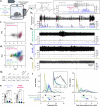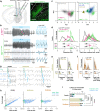Parabrachial tachykinin1-expressing neurons involved in state-dependent breathing control
- PMID: 36810601
- PMCID: PMC9944916
- DOI: 10.1038/s41467-023-36603-z
Parabrachial tachykinin1-expressing neurons involved in state-dependent breathing control
Abstract
Breathing is regulated automatically by neural circuits in the medulla to maintain homeostasis, but breathing is also modified by behavior and emotion. Mice have rapid breathing patterns that are unique to the awake state and distinct from those driven by automatic reflexes. Activation of medullary neurons that control automatic breathing does not reproduce these rapid breathing patterns. By manipulating transcriptionally defined neurons in the parabrachial nucleus, we identify a subset of neurons that express the Tac1, but not Calca, gene that exerts potent and precise conditional control of breathing in the awake, but not anesthetized, state via projections to the ventral intermediate reticular zone of the medulla. Activating these neurons drives breathing to frequencies that match the physiological maximum through mechanisms that differ from those that underlie the automatic control of breathing. We postulate that this circuit is important for the integration of breathing with state-dependent behaviors and emotions.
© 2023. The Author(s).
Conflict of interest statement
The authors declare no competing interests.
Figures






References
Publication types
MeSH terms
Grants and funding
LinkOut - more resources
Full Text Sources
Molecular Biology Databases

